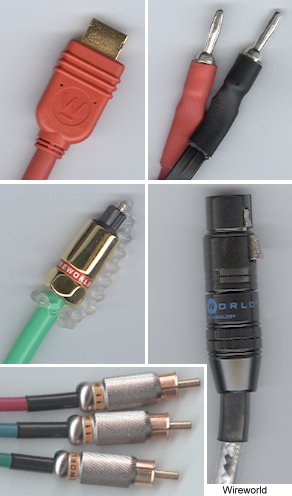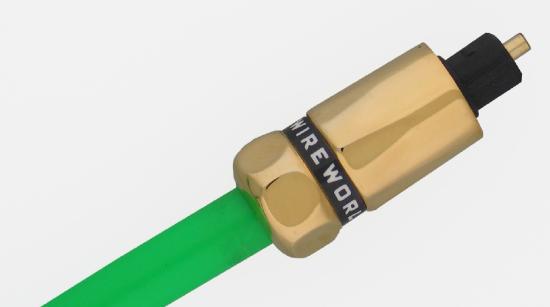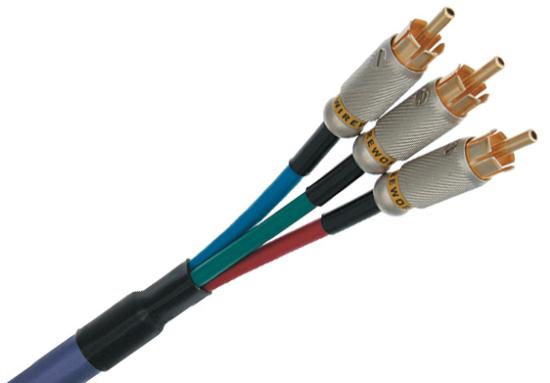|
|||||||||||||||||||||
|
Introduction Cables - as I have alluded to before - are an underappreciated item in the A/V world. We think, "It's just wire." It is true that it is wire, but not "just". They are conductors, like the ones inside the DVD players, Receivers, and Speakers. Manufacturers of our other components pay attention to the conductors they put inside, so why shouldn't we pay attention to the conductors we put outside? Well, there is no reason. We assume they are not important, so we use whatever comes in the box, or perhaps what our brother gave us when he moved into the college dormatory. In particular, the companies who manufacture the circuit boards on which many of the DVD player and receiver parts are mounted, pay great attention to the conductors, etched with copper foil into a maze across the board. That does not mean we have to pay a lot of money. It just means we have to watch what we are doing with the cables, just as we would with the other components. You can indeed spend mucho $$$ for cables. In fact, thousands of dollars. And, many audiophiles/videophiles do just that. But, you can also get very nice cables for reasonable prices. Wireworld is in the moderately priced arena. The Design Wireworld cables span a range in configuration, using simple copper with polyethylene dielectric, up to solid silver conductors and microporous Teflon. Connectors tend to be alloys of gold, silver, copper, and brass, even in the lower priced models. This is good. The connectors are just as important as the conductors. Wireworld sells through dealers, rather than on the Internet. In Use I tested the Wireworld cables in all three of our labs, since a variety of cable types were sent for review. I must say that these cables have some of the most solid construction that I have seen in cable design so far. In particular, I really liked the XLR cables. I have to bend XLRs through a maze of cabinet posts to go from the preamplifier to the power amplifier, and I always worry about kinking the cable or damaging the joints between the conductors and the XLR pins. But, the Wireworld are so solid, that was simply not on my mind when using them.
The Wireworld Toslink optical cable also really caught my eye. It is thicker than most Toslink cables, uses glass fibers instead of plastic, and has a cap retainer on the end (see photo). So, when you remove the cap, it stays attached to the cable rather than getting lost somewhere on the shelf. The Horizon speaker cable - now called Luna - has flat conductors spaced at a carefully specified distance. They lay one on top of the other, rather than side by side. I spoke with Dave Salz, Wireworld's founder and owner, about the design, and he told me that the Horizon was actually a pre-production configuration, and that they modified it to have the same conductor spacing, but overall, be round, so that it can be pulled through walls for custom installs. Also, the round shape lets an installer connect the terminations in a very easy manner. The flat conductor layout is to reduce induction. The sound quality that I experienced with the Wireworld cables was one of clarity and naturalness. I did not notice any harshness or attenuation of highs or bass. Video was also good with the HDMI and component cables. I had assumed that the video cables were unusually long, but Dave told me that the average length purchased is even longer than that. On the Bench The LCR data showed that the component video cables had about the same inductance as other RCA/RCA interconnects, but very near the low end of measured capacitance for interconnects. The Horizon speaker cables had higher capacitance than all of the other measured speaker cables except for one (Analysis Plus), while inductance was near the low end of measurements for all speaker cables tested so far. Click HERE to see the data table. In general, it is thought that having low capacitance for interconnects and low inductance for speaker cables is good, so the Wireworld cables have excellent LCR data. Below is a summary table of my evaluation of the Wireworld Cables.
Conclusions Wireworld doesn't sell on the Internet, so you will pay a bit more than you otherwise would, but the value is there, the sound and video are very satisfying, and the cables are beautifully constructed.
|
|||||||||||||||||||||








